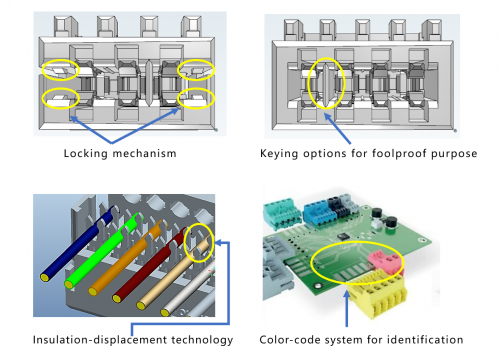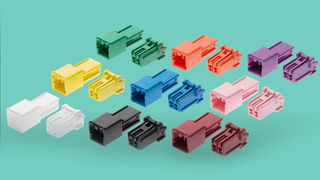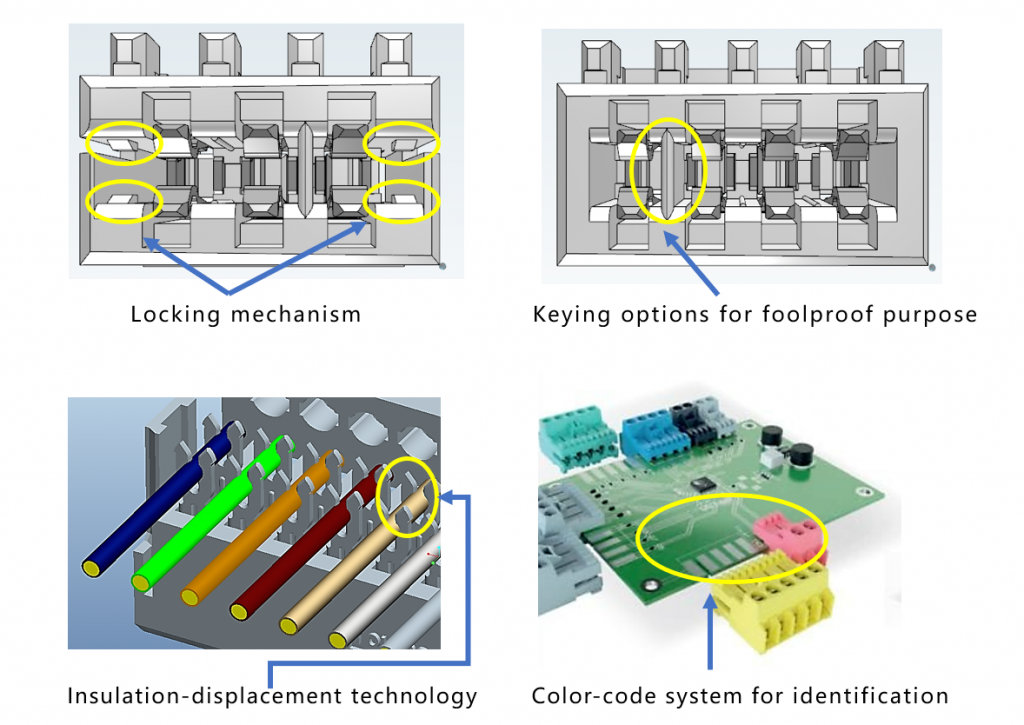Safe mating of connectors is critical in a variety of electronic and electrical systems. Mating is the process of accurately assembling a connector with its mating object to ensure a stable and secure connection. Due to the different sizes, shapes and application scenarios of connectors, mating techniques are also different, and the mating cycle of each connector is directly related to its quality and durability. To ensure the integrity and safety of the connection, connectors usually have multiple functions.

Here are some common and key features:
Color Coding
Color coding is one of the basic requirements to ensure the correct mating of connectors. By using different color codes for the connector’s header and socket, you can quickly identify its corresponding variant, such as power, signal or ground. This not only avoids incorrect connections, but also greatly saves time during on-site installation. Color coding provides installers with an intuitive visual reference, allowing them to quickly and accurately complete mating work in a complex connection environment.

Audible locking sound
An audible “click” is an important indicator of successful connector mating. When the connector’s header and receptacle are properly mated, you will hear a clear click, which not only provides audible feedback, but also enhances the feeling of tactile feedback. This feature ensures that the connector is mated successfully and securely. The click is an important feature in connector design, which can provide instant confirmation to the operator during the mating process, avoiding potential problems caused by improper mating.
Key polarization
Key polarization is a safety design element inside the connector that ensures that the connector can only be mated in the correct orientation. By incorporating protrusions into the structure of the connector, these polarization keys guide the mating direction of the connector, thereby preventing incorrect mating. This design greatly reduces the risk of poor connection or damage caused by human error. The polarization function is particularly important for complex connector systems, which ensures the reliability and stability of the system.
Hot Swap
Hot-swap functionality allows connectors to be safely connected or disconnected while the system is running, without disabling or shutting down the system first. This feature is designed to prevent electrostatic discharge (ESD) from damaging system components. USB connectors are a typical example of hot-swap technology, allowing users to plug or unplug USB devices at any time while the computer is running without affecting other system operations. Hot-swap not only improves system flexibility, but also enhances device convenience and user experience.
CPA vs TPA
The secure mating of connectors also relies on position assurance accessories such as CPA (Connector Position Assurance) and TPA (Terminal Position Assurance). These accessories are typically used to ensure that connectors do not slip or mismated after mating due to vibration or other factors. CPA and TPA provide double assurance through primary and secondary locking functions to ensure the correct mating of connectors. Especially in automotive applications, the automotive connectors produced by KONNRA have these functions, which can cope with the high vibration and harsh conditions in the automotive environment, ensuring the reliability and safety of the connection.
Summary
During the connector mating process, paying attention to these key features can effectively ensure the safety and reliability of the connection. Whether in complex industrial systems or in daily electronic devices, these features provide a strong guarantee for the stability and ease of operation of the connector.










